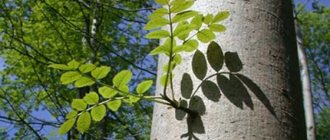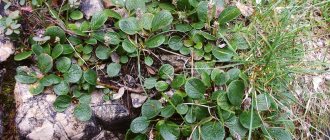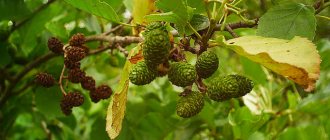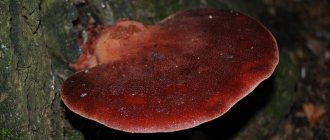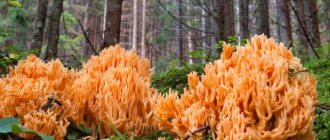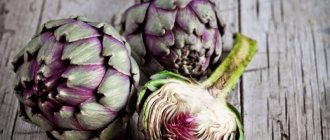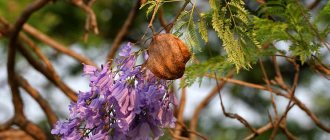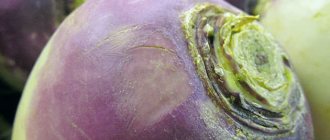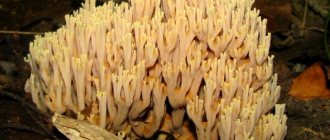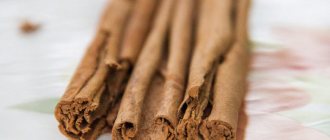- December 1, 2018
- Trees and shrubs
- Lyudmila Selivanova
What is alder, why do some consider it a tree, while others consider it a shrub? Both are true. It all depends on the conditions in which it grows. It can change its shape, taking on the appearance of a deciduous bush with cones, or it can transform and become a branched tree.
Let's talk about this magical tree with small cones, which at one time was considered sacred and was a symbol of fertility.
Myths and legends
There are many myths and legends about this tree. It is talked about in Greek mythology. Orpheus's first musical instrument was an alder pipe. The connection between the pipe and alder can be seen in the name of this musician, which, according to some historians, is a shortening of Orphruoeis - “growing on the river bank,” thereby indicating alder.
The shores of the caves of the sorceresses Sercea and Calypso, who held Odysseus, were overgrown with alder. The myths do not specify what type of alder this or that was, but in nature there are many varieties. The fact that the tree has ancient roots is evidenced by the existence of a certain tribe of Arverni - “people of the alder”, who lived in the territory where the Celts lived.
Application
Alder is widely used in various industries, namely:
- production of musical instruments, since the material does not form cracks when dried;
- when in contact with water, wood becomes stronger, so it is used to build wells or barrels;
- production of decorative furniture due to beautiful color and texture;
- when smoking meat and fish, preferably use plant wood;
- The black type is used to make dyes for cloth and leather.
Alder has many characteristics and beneficial properties, and therefore the wood is increasingly used in the manufacture of various items, as well as for the treatment of various types of ailments. Widely used in industry due to its ease and flexibility in processing without forming serious defects.
About the holy alder tree, watch the following video:
Alder growing places
The alder tree grows in North America, where it has long been called “alnus,” which translates as “coastal.” It belongs to the Berezov family, as having earrings and cones. The places where alder grows are different. These can be areas with high humidity: rivers, streams, swamps, lakes. It thrives in forest-steppe and mixed forests, where aspen, birch, spruce and oak trees are present. There are various types of alder in the regions of Western Siberia and the Urals. The range of gray alder covers most of Europe; the species is found in Asia Minor and some oases of North Africa. In the Carpathians and Alps it can be found at significant altitudes above sea level.
Growing environment
Alder grows in swamps, in places with high humidity, near rivers and reservoirs. It is most often found in the Urals, Western Siberia, forest and forest-steppe zones of the European part of Russia.
Neighbors of alder can be ash, oak, linden, aspen, birch, and also spruce trees.
There are about 40 species of tree around the world. Only a few of them are common in our state, the most popular of which are gray and black alder.
Read also: Methods of providing first aid for a chemical burn
Gray alder
This species is distinguished by an uneven trunk and gray bark. Can reach 20 meters in height. The flowering period can be determined by the presence of brownish catkins. The foliage is grayish in color, slightly pointed at the top.
The tree is resistant to frost and strong winds. Thanks to its unpretentiousness, it feels great even on poor soil. The most important factor is sufficient sunlight.
Black alder
The plant has dark bark with cracks formed, the leaves are obovate in shape.
This species grows up to 35 m, loves moisture and running water, and will not grow in a swamp. Black alder is famous for its pink wood with a smooth iridescence, due to which it is widely used for industrial purposes.
In addition to these species, in the east of Russia you can find green, Siberian, fluffy and bush alder.
Types of alder
In total, botanists have confirmed the existence of about 40 species of alder. The most common ones include:
- black alder, which is considered one of the best medicinal species;
- gray alder with ovate leaves and shallow roots;
- white, with light gray bark and leaves with double-serrate edges;
- red straight-barrel;
- shrubby alder, growing rapidly.
In addition to the above species, in Siberia and the Far East you can find: Siberian, fluffy, Japanese, Italian, which are interspecific hybrids, and the established names refer more to the places where these types of alder grow.
Habitat
The tree is common in areas that fall in the temperate climate zone. The habitat also depends on the life form of the plant. Therefore, it can be found even in the mountains of South America.
Related article: Ketembilla description and features
Most often, alder grows on marshy soils in forests. Its habitat also extends to the tundra, which is located in the subarctic climate zone.
Alder tree: description
If we consider the features of appearance, everything depends on the places where it grows, the species to which it belongs, as well as the soils on which it grows. A tree that grows on fertile soil can reach a height of up to 25 meters by the age of fifty. Black alder grows up to 35 meters. What does alder look like on soils with poor fertility? It grows as a bush, living up to 60-70 years.
Alder has a lush crown. But it is not uniform, somewhat sparse due to the uneven arrangement of branches. Alder is one of the first to signal that spring has come. This is manifested in the abundant flowering of the tree. At this time it stands decorated with beautiful earrings, which are divided into men's and women's. Women's earrings are no more than 1 cm in size, and men's ones reach sizes of 5 - 9 cm. The article presents species photos of alder trees and leaves that appear after flowering.
Varieties
In our country you can find two types: black and gray. Each of them has its own characteristics and the following description of the types will help not to confuse them.
Black - grows up to 30 m in height and up to 80 cm in diameter. Gray - often grows into a dense bush. Sometimes it is no more than 15 m in height and no more than 30 cm in thickness.
The difference lies in the color of the bark and the shape of the leaves. The first type has dark, sticky, egg-shaped leaves. The second variety has leaves that are usually elliptical in shape with sharp edges.
Let's look at where each species grows. The black variety predominates on the wet coasts of rivers and lakes. Gray - can be seen on dry hills. It freely occupies cuttings, wastelands, and ashes.
True, the humidity and nutritional value of the soil are similar. Glued is so named because the young leaves are very sticky. And dark crusts form on old black alder trunks.
Fruit
Alder cones of different sizes are fruits. Depending on its type, they are filmy and leathery, while others are wingless. The cones hang closed on the alder all winter, opening only in March and sowing the soil with their seeds.
The cone harvest can be harvested in late autumn and winter if the alder grows on a personal plot. When harvesting cones, they are cut with garden shears. The buds are dried at room temperature. Dried fruits become brown or brown in color. They give off a light aroma. They have an astringent taste.
Black alder
Alder blooms in April and is pollinated by the wind before its oval or round leaves bloom. She had prepared for spring flowering the previous summer. It is at this time that men's earrings are laid, which grow and form until late autumn. They have a supply of pollen ready for winter. The fruits of this alder ripen by the spring of next year. They are cones with a narrow wing. This can be clearly seen in the photo of the tree and alder leaves.
The bark is dark in color, and there are a significant number of cracks on old branches.
Black alder is found in North America, Europe, Ukraine and the Baltic countries. Loves wetlands. Sometimes black alder looks like thickets, especially in places where there is a stream or small river. There is even a popular saying: “Where there is good alder, there is heaps of hay.” This type of alder is included in the Red Books of Kazakhstan, Moldova and some regions of Russia. Black alder is quite often used by landscape designers for planting valley parks.
Black alder has a significant number of decorative species, differing in the shape of the leaf blade and the shape of the crown. What does alder of these ornamental species look like? For example, oakleaf has lobed leaves similar to oak leaves; the mountain ash has pinnately lobed foliage; Tsarina has small, more deeply cut leaves. And all this is alder.
Area of application of black alder
A characteristic feature in the description of this type of alder is the value of its wood. In ancient times they knew that it was durable and did not rot, so it was used for lining wells, making barrels and underwater structures. When drying wood, cracks do not form on it. This makes it possible to make musical instruments from it, in particular, flutes and pipes.
In ancient times, shoes were made from wood and alder bark. Due to the pliability and softness of wood, it is used for making sculptures and panels. After felling, alder wood changes its color from white to red. When it is treated with ammonia and drying oil, it acquires a beautiful sheen. Samples of decorative furniture are constructed from such wood. They make amulets, talismans and amulets from alder, sincerely believing that they will help protect both the home and the person.
In folk medicine, alder bark and cones, which contain large amounts of tannins, are used. Young leaves are used to treat purulent wounds, and for diathesis, a decoction of black alder flowers is prepared. Alcohol infusions of alder catkins are used for constipation.
Scope of use
Alder is highly valued not only because of its beautiful appearance, since it has many other useful qualities.
In decorative arts
Alder, which is grown from young seedlings, grows very quickly, often leading to the growth of wild thickets. At this stage of its life cycle it has a uniform wood structure and is easy to work with. Therefore, it is often used in industry.
Alder is one of the most common materials for creating artistic carvings It is used for the production of carved dishes, sculptures and decorative panels. After processing the wood using dry distillation, coals are obtained that are highly valued by artists. Specimens whose trunks are decorated with beads are of great importance in decorative art.
In folk treatment
This plant is also valued as a remedy for treating many diseases. The bark, leaves and cones enriched with tannins have beneficial properties. Tinctures and decoctions are considered effective healing agents , as they have anti-inflammatory, astringent, hemostatic, antibacterial and disinfectant properties.
- to combat eczema and diathesis, use a decoction of flowers, which must be prepared at the beginning of flowering;
- an alcohol infusion of earrings can help people suffering from constipation and hemorrhoids;
- if there is a purulent wound, then you need to apply black alder leaves to it, and it will heal quite quickly.
After a course of antibiotics, you can restore the natural intestinal microflora using a decoction of cones. This remedy will also help cope with diseases of the gastrointestinal tract. It is often used for conditions such as:
- cold;
- inflammation of the throat and nasopharynx;
- pharyngitis;
- angina.
To stop nosebleeds , it is necessary to keep tampons made from fresh leaves in the sinuses. Traditional healers advise using a decoction to combat joint pain, arthritis and gout.
Alder in medicine drawing
Dry baths are an effective remedy ; they are made using fresh leaves.
- they must be heated in an oven or in the sun, and then the leaves are laid out on a bed and the sick person is placed on them. You can also cover the affected parts of the body with heated leaves, and wrap yourself in a warm blanket on top. In this case, the result will be maximum when this procedure lasts at least an hour;
- This remedy will work even better when the leaves are heated in a deep tub, where the patient must then be seated up to the neck. Using the same scheme, you can fight diseases with the help of birch leaves.
When visiting the bathhouse, it is quite useful to use alder brooms , which have a tonic, disinfectant, cleansing effect, filling the body with energy.
In industry
The ease of processing wood has led to its frequent use in industry. Various operations can be performed on this wood, including staining, varnishing and polishing. Also, this wood maintains the integrity of the structure when screws are screwed into it. Changes can occur when hammering nails, this is reflected in the delamination of wood.
Drying alder will not affect its properties in any way: it does not last long, and during this operation no defects in the form of cracks or warping appear. This property has made alder the most popular material for the production of musical instruments.
Use of alder in industry
Gray alder
Trees of this species can be found on the dry hills of the European part of Russia. This is a low-growing plant, often looking like a large shrub with shallow roots. Gray alder can often be seen on the edge of spruce forests and in fields that once served as arable land. Why is this type of alder called gray? Most likely, this is due to the color of the bark and the shade of the alder leaves, which occurs due to the small edge that gives it a silvery appearance. Further in the article there are photos of the tree and alder leaves, which are ovoid in shape. The slightly pointed tip of the alder leaf gives it a similarity to a birch leaf. Gray alder, like black alder, blooms long before the leaves appear.
As mentioned above, gray alder has shallow roots. Microorganisms settle in them, which, absorbing nitrogen gas from the air, convert it into nitrogenous compounds. Due to this, gray alder is a natural creator of nitrogenous fertilizers. There is another interesting property of the tree: in autumn, alder leaves look green like in spring. The tree sheds its leaves, which are not colored crimson and gold, in preparation for winter. They remain green when they fall to the ground and rot very quickly, improving the top layers of the soil.
Decorative forms of gray alder are varied. For example, blue alder, common in North America, has the form of a shrub or low (6 meters) tree with bluish-colored leaves, sometimes with a lower edge. The golden color of the shoots is reddish, and the leaves are pubescent and slightly yellowish.
There is a variety of decorative gray alder called ugly alder. It has flat, creeping branches.
What does Alder look like?
Often catching the eye of people, Alder always remains invisible. In the spring, its foliage quickly darkens, and in the fall, when all the trees put on bright outfits, it remains unchanged. At the time of leaf fall, the Alder leaf will only shyly curl up and imperceptibly fall to the ground.
Read also: Sheep shed photo
But in winter it is not difficult to recognize Alder by the small cones on the branches and in the snow.
The Alder trunk is mostly slender and covered with smooth bark. The trees grow quickly, reaching a height of more than 20 meters.
Gray alder is a deciduous tree or large shrub with a rounded silver-gray crown. The trunk is curved, with gray bark. The leaves are gray on the inside and sharp at the end. Flowers are unisexual. The female ones sit in the axils of the inflorescence, turning into a small cone by autumn. The sticky alder has greyish-brown bark, and the foliage is sticky and shiny, dark green above and dull below.
Area of application of gray alder
The wood is used to make decorative jewelry and furniture. Red, brown and green dyes are obtained from tree bark. Gray alder is not susceptible to rotting in water. Like black, it was used in the foundations of some medieval cathedrals. Many of Venice's cathedrals and castles still stand on alder stilts, as do the watermills of Scotland. The gunsmiths of the Middle Ages knew a lot about alder firewood. They valued the wood as best for charcoal, which was used to melt metal for swords.
Beekeepers know that alder pollen is an excellent food for bees. In folk and official medicine, alder is widely used due to its tannins, vegetable and essential oils.
Infusions from lignified alder cones are used for all kinds of inflammatory diseases of internal organs, as well as in the form of dressings for non-healing trophic ulcers, eczema and burns. A broom made from branches and leaves is an excellent bactericidal agent that tones the skin in the bath.
Application in construction
The wood of this tree is used not only independently, but also as a component in the production of particle boards, plywood, and veneer. This is justified by its antiseptic qualities due to its astringent properties. Each type of alder has its own characteristics that determine its area of application.
Black alder is considered the most sensitive to temperature changes, so they try not to use it in the decoration of saunas and baths. What needs to be taken into account when working with alder is that this wood is quite soft and still requires treatment against pests and moisture. Its main advantage is its long service life and the fact that the fibers have a beautiful texture. This species is used to make crafts, toys, paper, and is used as fuel.
Products made from gray alder are better suited for use in wet conditions, which expands the scope of its application. This wood is also ideal for making eco-friendly toys, shoes and some turning tools.
Houses, saunas, baths
The advantages of this type of wood include the ability to stain beautiful shades and even achieve an imitation of more valuable wood species. Alder boards have healing properties, so they are well suited for interior decoration of houses, saunas and baths. The advantages of building materials made from alder wood are:
- resistance to deformation at high temperatures;
- lack of release of resinous and other harmful compounds;
- ability to absorb moisture well;
- excellent sound and heat insulation properties;
- the fact that condensation does not accumulate on the surface of this wood;
- low thermal conductivity - this reduces the risk of burns to a minimum.
Read also: Rose trezor encyclopedia of roses
When constructing structures, it is important to take into account one nuance - alder boards should not come into contact with the ground.
Doors, laminate, furniture
This solid wood makes excellent interior doors. Thanks to various treatments, they can be used in any interior, while the price remains quite affordable. Alder doors are completely safe, and also have antibacterial and anti-allergenic properties; they can even be used in children's rooms. They serve for quite a long time.
Alder laminate not only meets all technical requirements, but also has an attractive appearance. It can be considered as a replacement for elite parquet. Such floors do not get too dirty, are easy to clean, and do not require much time for maintenance or any special means for this.
Not only solid wood is used to make furniture; alder is also used in plywood, chipboard and furniture panels. In operation, these types of materials provide the best wear resistance, they do not chip, and are not subject to deformation. Alder furniture is lightweight, but at the same time quite durable.
It is important to know that when working with wood, it is better not to use nails; when driven in, they can split the material. In this case, screws will be an excellent replacement.
Italian alder
Grows in Italy and Albania. This is Alnus cordata - Italian (heart-shaped). The article presents a photo of a tree and leaves of an alder of this species, which is often confused with Alnus subcordata - heart-leaved. Italian alder has an ovoid crown. Its leaves are dense, smooth, oval in shape. They remain on the tree until December. The shape resembles cherry leaves. The bark of the tree is dark brown.
Growing alder in garden plots
Many summer residents like to plant ornamental trees and shrubs in their garden plots, turning part of the plot into a piece of a fairy-tale forest. Alder is no exception, especially since its bark, fruits, leaves, and pollen are good folk medicines that are good to always have “at hand.” You can plant ready-made perennial alder trees, small seedlings purchased from nurseries, seedlings from shoots dug up in growing areas, or wait for the seeds of one or another type of alder planted on the site to sprout.
Alder is a large tree. They have a powerful root system, a height of more than 15 meters, and a well-formed crown. If a sufficiently mature tree is planted on the site, the process is labor-intensive. Here you need equipment that will bring the tree and plant it in the prepared place. Planting can be done at any time, but the best option would be to plant alder in the fall and even in winter, when the tree is least responsive to temperature changes and is at rest.
In central Russia, planting time is from November to March. Caring for a tree planted in this way involves intensive watering and loosening in the first year after planting.
In the nursery you can buy shrubby alder, which reaches a height of 3 meters, or is formed in the form of a small tree, which is rarely taller than 10 meters. Shrub alder grows quickly, is not picky about soil, and requires moisture. Alder will transform even the most inconspicuous piece of a personal plot, turning it over time into a cozy green corner.
